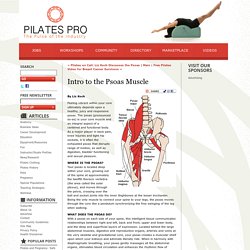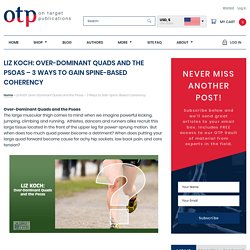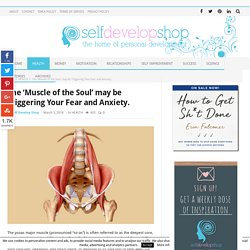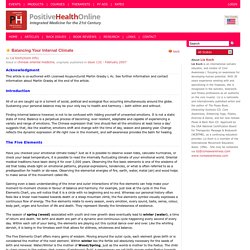

The Psoas Is the Important Muscle Where Your Body Stores Your Deepest Trauma. Trauma affects people in different ways—physically and psychologically.

But did you know your body may be storing your trauma in a muscle you’ve probably never heard of? It’s that pesky psoas (SO-az) . Your body is built to react to traumatic experiences physically. Think of it as a basis for survival. Have you ever heard stories of how people acquire superhuman strength and can move a car to save someone? Even your very cells react to and store trauma. If these physical responses remain “stuck,” they begin to cause issues. Your psoas is the strongest muscle in your hip flexors, and it contributes to nearly everything you do— from posture to core strength to moving your legs pretty much at all. If you’ve ever done yoga, you know that almost everyone has tight hips, even people with flexible hips. When you think about it, your hips don’t really move much throughout the day—in the course of normal activity, the rest of your body sort of ends up moving around your hips.
Namaste. Intro to the Psoas Muscle - Liz Koch. By Liz Koch Feeling vibrant within your core ultimately depends upon a healthy, juicy and responsive psoas.

The psoas (pronounced so-as) is your core muscle and an integral aspect of a centered and functional body. As a major player in back pain, knee injuries and tight hip sockets, it is often the exhausted psoas that disrupts range of motion, as well as digestion, bladder functioning and sexual pleasure. Relax Your Core: 5 Poses to Release Your Psoas. By: Christine Malossi, RYT 200 You may not think about this while you're practicing yoga, but deep within the center of your body, beneath layers of skin, muscle, and organs, lies the psoas (pronounced “so-as”).

It is the deepest of your core muscles—the very core of your core. You actually have two psoas muscles, one on each side of your body. Each begins at your 12th thoracic vertebra, attaching there and to each of the five lumbar vertebrae below. Trauma & The Psoas: An Interview with David Berceli. Liz Koch: Over-Dominant Quads and the Psoas - 3 Ways to Gain Spine-Based Coherency.
Home » Liz Koch: Over-Dominant Quads and the Psoas – 3 Ways to Gain Spine-Based Coherency Over-Dominant Quads and the Psoas The large muscular thigh comes to mind when we imagine powerful kicking, jumping, climbing and running.

Athletes, dancers and runners alike recruit this large tissue located in the front of the upper leg for power-sprung motion. But when does too much quad power become a detriment? When does putting your large quad forward become cause for achy hip sockets, low back pain, and core tension? To truly understand the relationship between the over-dominant quad (consisting of four muscles spanning from pelvis to knee) and the core psoas (consisting of two muscles spanning from spine to inner leg) it behooves us to shift our thinking away from the culturally preferred biomechanical paradigm to a fresh bio-intelligent paradigm called embryology. Human beings are biologically defined as spine-based organisms long before arms and legs begin to bud. Embryology vs. Unraveling The Psoas Muscle On Land - Using A Chair. The Muscle of the Soul may be Triggering Your Fear and Anxiety. The psoas major muscle (pronounced “so-as”) is often referred to as the deepest core, or as yoga therapist and film-maker Danielle Olson states, the muscle of the soul.

This core-stabilizing muscle located near the hip bone affects mobility, structural balance, joint function, flexibility, and much more. In addition to its function to help keep the body upright and moving, the psoas is believed to allow you to connect with the present moment especially when it is stretched out and tension is released from the body. Research indicates that the psoas is vital to our psychological wellbeing in addition to structural health.
Liz Koch, author of The Psoas Book, states that our psoas “literally embodies our deepest urge for survival, and more profoundly, our elemental desire to flourish.” This means that there is a lot more to the psoas than one might initially think. The Best PSOAS Muscle Fix: MUST WATCH! How To Unlock Your Psoas & Use It To Decrease Stress. Chinese Medicine and the Psoas. Acknowledgment This article is co-authored with Licensed Acupuncturist Martin Grasby L Ac.

See further information and contact information about Martin Grasby at the end of the article. Introduction All of us are caught up in a torrent of social, political and ecological flux occurring simultaneously around the globe. Sustaining your personal balance may be your only key to health and harmony – both within and without. Finding internal balance however, is not to be confused with ridding yourself of unwanted emotions. Psoas Release Work Is Magical. Psoas release work can provide a great deal of relief to people suffering back, hip, groin, and other types of pain.

The goal of a psoas release is to create an environment where the psoas major can let go of chronically held tension that might get stored in this profound muscle. This type of psoas release is often found by putting yourself in a position to relax the psoas muscle while making use of the gentle force of gravity to create space in the body’s core.. Many approaches to pain relief involve doing something active to heal the body—there are many injuries that can be rehabilitated through stretching, manipulating, stimulating and even in some cases medicating. But what if these approaches have not worked and you are still suffering pain? I’m comfortable as an iconoclast but when I decided to teach people to walk as a means to pain relief I didn’t expect people to look at me like I was an alien. The Psoas: Muscle of The Soul – body divine yoga. I was delighted when I first came across Liz Koch’s amazing work because it confirmed much of what I’d been intuiting on my own.
I had begun to open and close my yoga practise with hip opening poses with the specific intention of releasing tension in my psoas and hip flexors. I’d breathe and imagine tension flowing out of constricted muscles to be released as energy into the torso. It worked, I’d feel my body soften yet somehow grow stronger. Reading Liz Koch I instantly realized what I was doing – by learning to relax my psoas I was literally energizing my deepest core by reconnecting with the powerful energy of the earth.